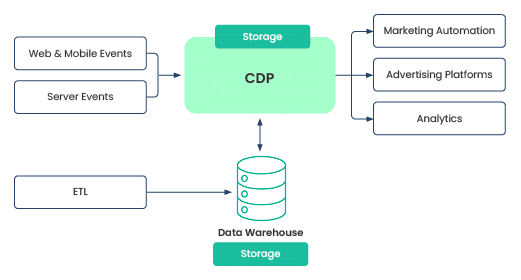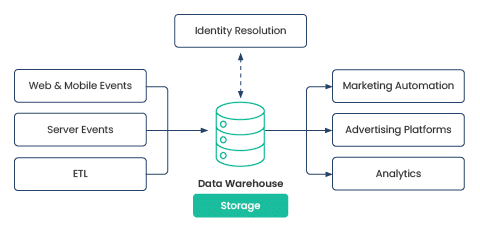This blog was co-written by Alex Roed, Luke Kline, Sam Hall, Alec Haase, and Christian Franklin.
Modern marketing is changing. Consumers are expecting more personalized experiences, and marketers are managing more channels than ever. The depreciation of third-party cookies has only compounded this problem, leaving companies scrambling to figure out how to implement the systems needed to power growth with their first-party customer data.
For years, marketing teams across industries have turned to implementing traditional Customer Data Platforms (CDPs) as separate systems purpose-built to unlock growth with first-party data.
However, thanks to the recent rise of modern cloud data warehouses like the Snowflake Data Cloud and powerful tools like Hightouch, Fivetran, and dbt, many organizations are now realizing they can simply implement CDP features on top of their existing data infrastructure, thus giving birth to a new solution that marries the best of both data and marketing worlds: the Composable CDP
In this guide, we’ll break down everything you need to know about CDPs and discuss why companies everywhere are racing to adopt this new architecture.
Download a free PDF by filling out the form.
What is a Customer Data Platform?
Before covering the broader CDP landscape, it’s important to first provide some context on what a CDP is.
A CDP has historically been an all-in-one platform designed to help companies collect, store, and unify customer data within a hosted database so that marketing and business teams can easily build audiences and activate data to downstream operational tools.
The market is full of different CDP vendors, each specializing in slightly different verticals or use cases. However, almost all CDPs aim to perform the same four functions:
1. Event Tracking: Capturing behavioral events such as page views, add-to-cart, signup, purchase, subscription, etc.
2. Identity Resolution: Merging behavioral events and customer identifiers in an identity graph to create a single comprehensive customer profile.
3. Audience Management: Building and segmenting cohorts based on events, attributes, and user traits (e.g., an audience of high LTV users in the United States who abandoned their shopping cart in the last seven days.)
4. Activation: Automating data syncs (events and audiences) to operational and marketing tools so marketing teams can drive business value and personalization.
These functions work together with a promised mission of enabling businesses to leverage their customer data to drive more effective marketing and deliver personalized experiences.
What’s Driving CDP Adoption?
The push towards adopting CDPs stems from a universal realization among marketing and data professionals: the necessity for a unified system that seamlessly collects and integrates customer data throughout the business.
This need has positioned CDPs as the preferred tool for crafting personalized marketing strategies–becoming the defacto answer when CMOs face personalization challenges. The driving forces behind this adoption can be distilled into several key areas:
Data Fragmentation: Companies no longer want to hop back and forth between tools to try and gain the full context. They want one platform that houses all of their customer data across all of their sources.
Customer 360: Every company is constantly trying to merge and link the different actions of their customers into a single unified profile that can be leveraged across the business.
Business Alignment: Data and marketing teams have traditionally worked in silos, but companies are realizing that marketing teams need access to data to run campaigns.
Personalization: In order to deliver personalized experiences, marketing teams need and want a central platform where they can build audiences, manage campaigns, and orchestrate customer journeys.
Data Governance: With the phase-out of third-party cookies and new privacy laws arising, companies are coming under increased pressure to ensure compliance with regulations like GDPR, HIPAA, and CCPA.
Lifecycle Marketing: Marketing doesn’t just take place on one single channel any more. Campaigns are becoming more and more sophisticated as marketers are increasingly asked to build and deliver consistent experiences across ads, email, SMS, push, etc.
ROI: Data is no longer just an analytics asset for strategic decision-making. Companies want to leverage insights to drive action that translates into business value and, ultimately, revenue.
Understanding the CDP Market
If you’re evaluating CDPs today, there are two main options: Traditional CDPs vs. Composable CDPs.
Traditional CDPs: These platforms are out-of-the-box solutions designed to gather and house their own data store – separate from your core data infrastructure. Characterized by their plug-and-play nature, traditional CDPs often come with lengthy and costly setup processes predicated on rigid data model prerequisites.
Engineered primarily for the accumulation and preservation of behavioral events, their rigid architecture and out-of-the-box models may not accommodate the nuanced demands of modern businesses beyond standard customer and account information.
Composable CDPs: In contrast, Composable CDPs present a more flexible and integrated approach, seamlessly integrating with your existing data ecosystem. These platforms excel in ingesting, organizing, and deploying data directly from and to your cloud data warehouse, thereby preserving the integrity and accessibility of your customer data within your own cloud infrastructure.
The Composable CDP empowers organizations to utilize their pre-existing data investments and analytical frameworks, offering a tailored and scalable solution that evolves with changing business needs and demands.
Components of a Composable CDP
A Composable CDP has the same goal as a traditional CDP: activating unified customer data to downstream tools. But rather than operating as a separate entity and storing data outside of your current data infrastructure like a traditional CDP, a Composable CDP lets you create audiences, personalize journeys, and send your existing customer data directly from your data warehouse to your many marketing tools.
The components of a Composable CDP can be broken down as follows:
Data Collection: For batch data sources like SaaS applications and on-prem systems, Fivetran is the standard. The ELT platform offers 200+ pre-built connections to centralize data to any data platform. For behavioral data, Hightouch offers an event tracking SDK to deploy an SDK across your web, server, and mobile apps.
Data Storage: The Composable CDP can work with any cloud data platform, but many companies tend to use Snowflake due to its ease of use, scalability, and flexibility.
Data Modeling: For data modeling, there are two core use cases: (1) transforming your data into structured tables and models to understand your business and (2) performing identity resolution to merge and deduplicate known and unknown user profiles to create a unified customer profile. dbt has become the standard for modeling. Hightouch additionally offers an identity resolution feature that lets you build and maintain an identity graph directly within your existing data platform.
Activation: Activation is the final and most important aspect of a Composable CDP because it’s the actual interface that allows your marketers to self-serve off of the warehouse. Most companies rely on Hightouch because the platform offers no-code audience and journey builders for non-technical users to deploy audiences and data to over 200 destinations.

Choosing your CDP
Ultimately, the decision between a Composable and a traditional CDP should be based on a thorough assessment of your organization’s current capabilities, future growth plans, and the specific goals you aim to achieve through the implementation of a CDP. While every CDP is different, this framework should help you evaluate vendors more efficiently.
Security: Does the platform ensure high standards of data protection and compliance with privacy regulations? Consider if owning data storage within your own infrastructure is important to meet your organization’s security requirements.
Flexibility: Evaluate the CDP’s adaptability in meeting your marketing needs and if it integrates with your current and future technologies (ad platforms, CRMs etc). Additionally, consider if the CDP can accommodate your organizations data models without significant workarounds and engineering effort.
Time-to-Value: How quickly can the CDP be implemented, and how soon can you start extracting value from it? Assess if the solution lets you immediately power use cases with the data already residing within your warehouse.
Scalability: Consider the platform’s capacity to handle larger volumes of data and complexity as your business grows. Determine whether you prefer a solution that allows for easy modification and expansion–avoiding the risk of investing in all-in-one technology that may become obsolete or inadequate as your needs evolve.
For organizations that prioritize data ownership, rapid time to value, and prefer to integrate closely with their data warehouse, Composable CDPs offer a more suitable solution. These platforms are designed to quickly and easily integrate with an organization’s existing data infrastructure, facilitating immediate use and flexibility.
Conversely, traditional CDPs may be more appropriate for smaller organizations at an earlier stage of data maturity or those with no desire for data ownership. They provide a structured, out-of-the-box solution that can simplify the early process of centralizing customer data, making them a practical entry point for early-stage businesses just beginning to explore first-party data strategies.
Download a free PDF by filling out the form.
What Factors Impact Cost?
Pricing can vary substantially across CDP vendors; unfortunately, it’s not an “apples-to-apples” comparison. Based on our experience working with many different vendors, two main factors impact the cost:
The number of features/capabilities you need (e.g., event collection, audience management, identity resolution, activation, etc.)
The amount of data you collect and store.
Note: With a Composable CDP, every feature is decoupled, which means you can purchase components individually rather than being forced to pay for shelfware. Additionally, because Composable CDPs simply connect to your data infrastructure, you don’t have to pay for storage, like you would with a traditional CDP.
The most basic version of a traditional CDP usually starts at around $50,000 to $150,000 annually. However, depending on your data volume, this number can quickly skyrocket into millions, which is another reason why companies are switching to Composable CDPs that read directly from their existing store of data.
How Do You Get Started with the Composable CDP?
One of the biggest advantages of the Composable CDP is that it works on any infrastructure at any data maturity level. At phData, we can help you begin by thoroughly understanding your requirements, assessing current data capabilities, defining business objectives, and prioritizing use cases.
We’ve worked with companies across all industries and verticals to help them activate the data in the warehouse across their operational tools, and as such, we’ve developed a structured approach to help you go from zero to 100 in a matter of weeks to ensure the highest probability of success for your business.
We’ll help you prioritize CDP capabilities based on your business goals and construct a compelling business case by performing ROI and cost-benefit analyses to align internal stakeholders. We’ll also walk you through a thorough proof-of-concept (POC) so you can choose the right Composable CDP–all with hands-on training so your team can start driving value immediately.
Next Steps
First-party data matters more than ever before. Thanks to the rise of the Composable CDP, organizations now have the choice to bring their marketing and data investments together with a Composable CDP. One of the biggest advantages of the Composable CDP is that it works on any infrastructure at any maturity level.
If you want to learn more about the Composable CDP, you can schedule an introductory conversation or book a demo with a solution engineer to see how phData and Hightouch can help.


















